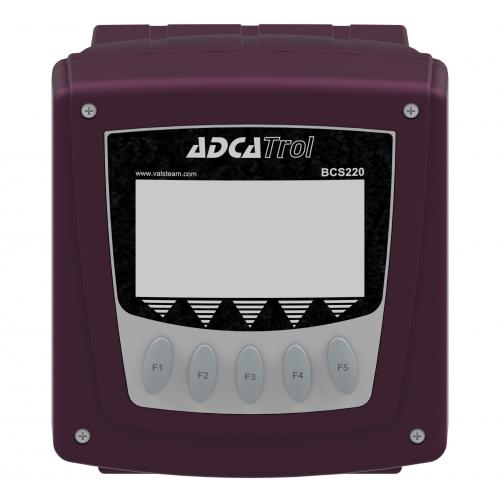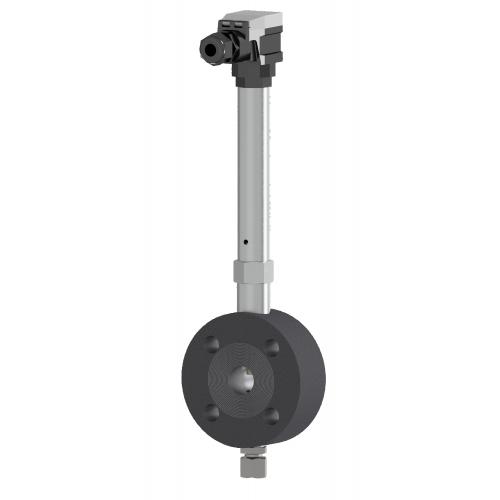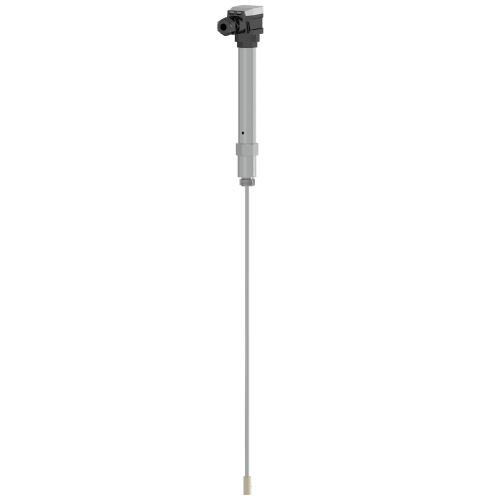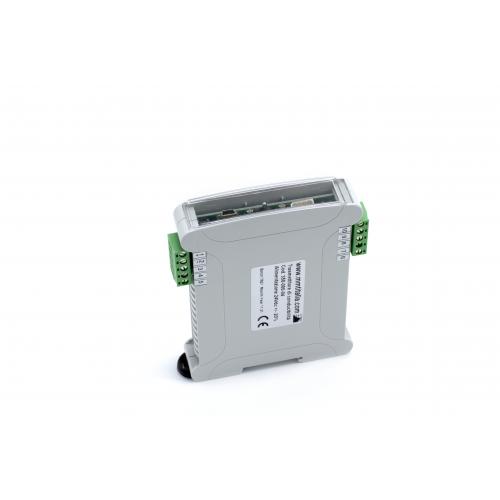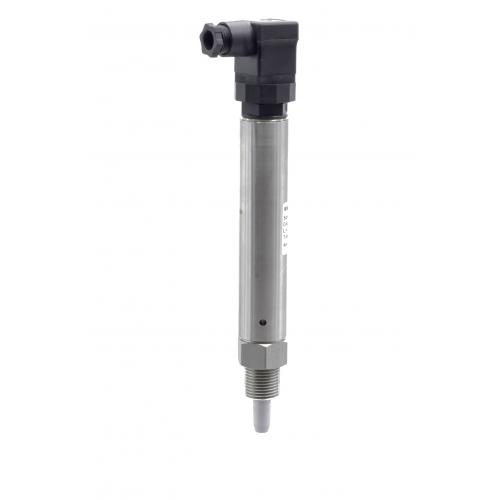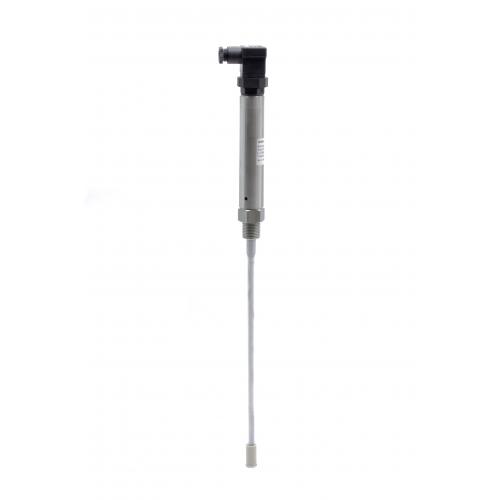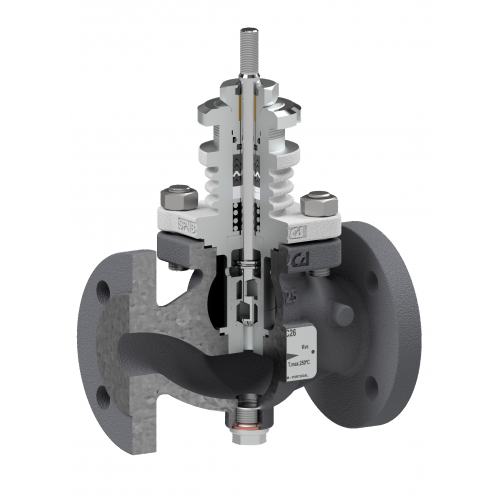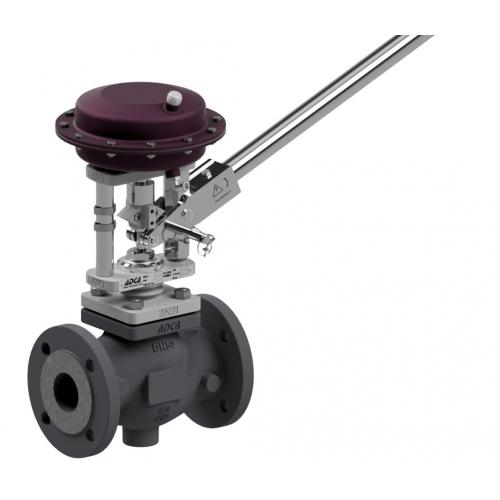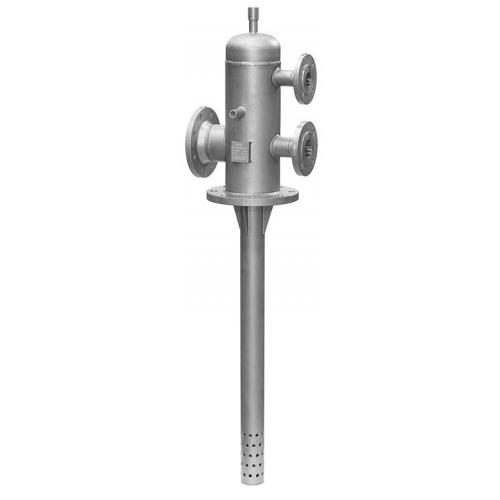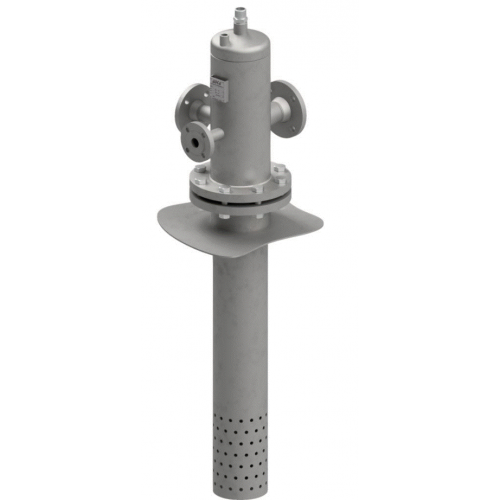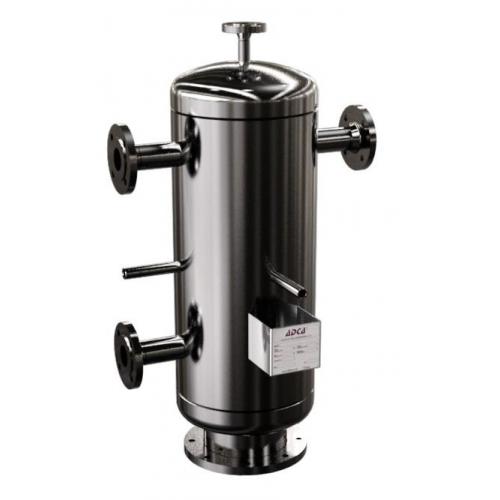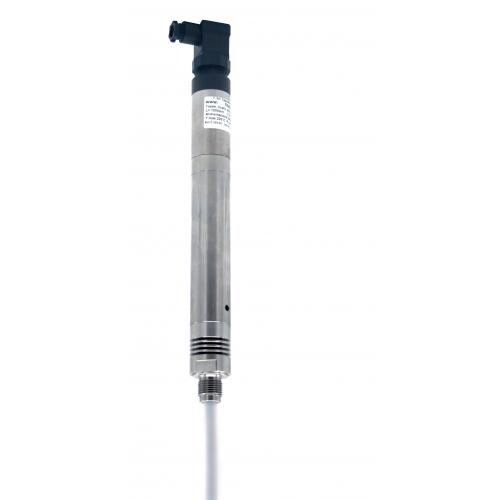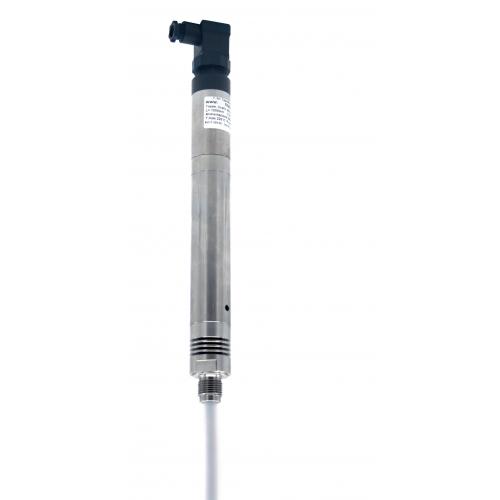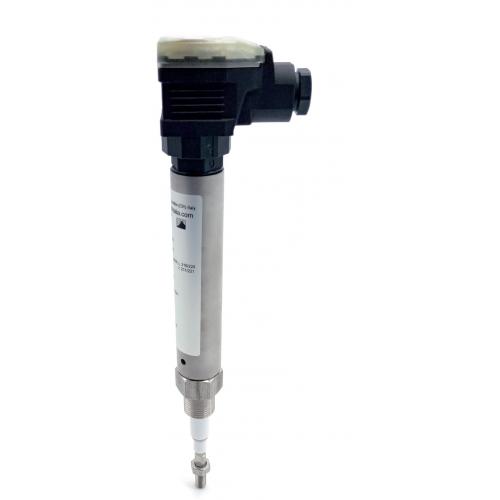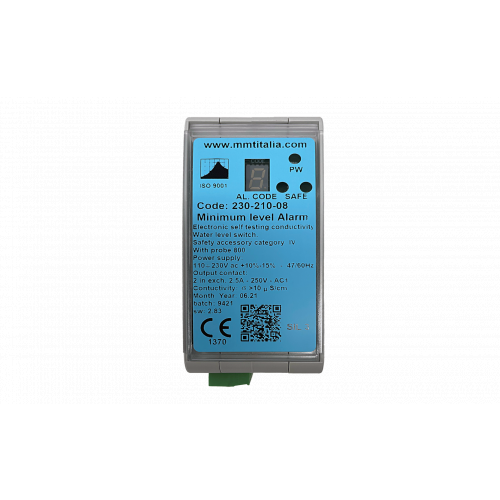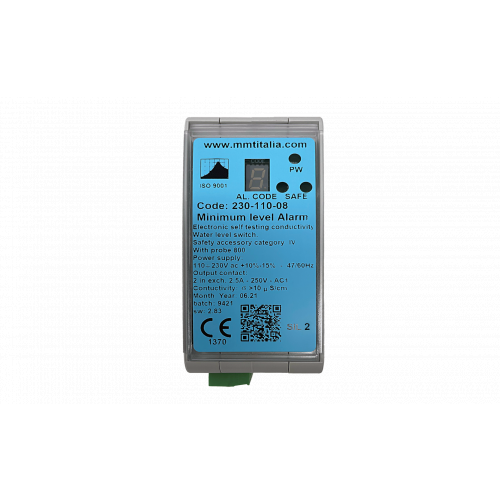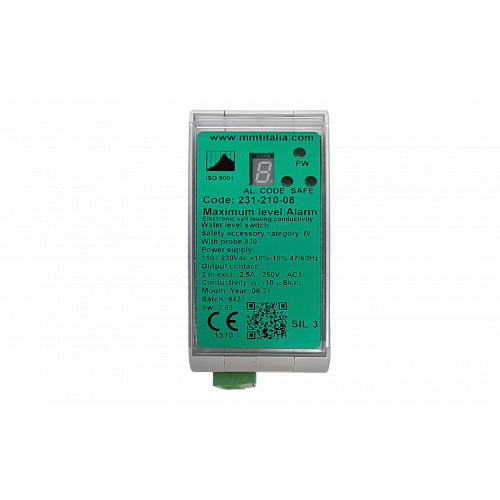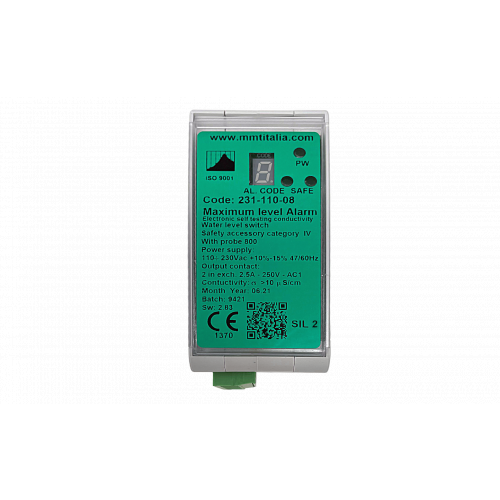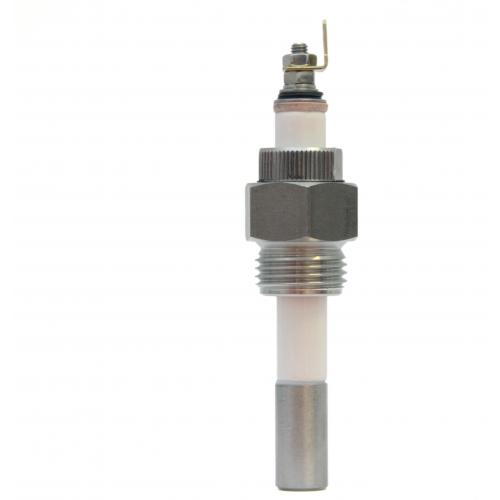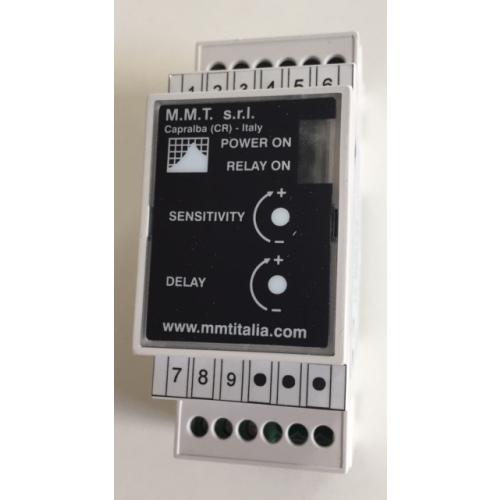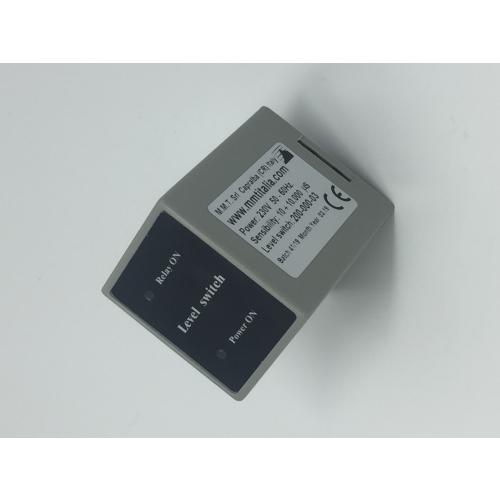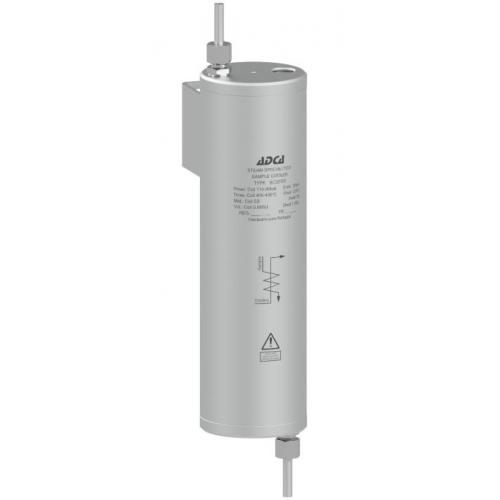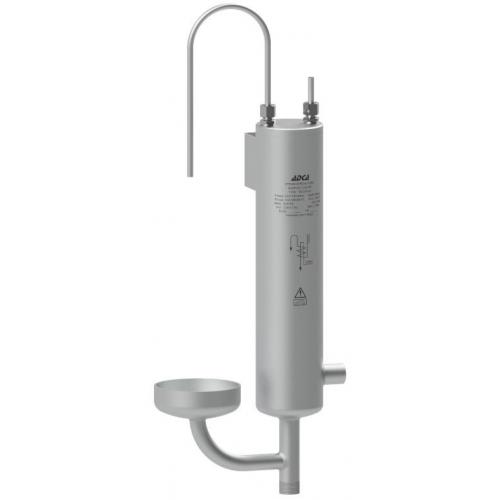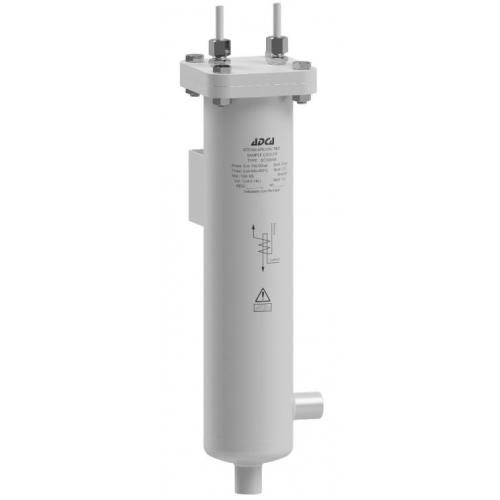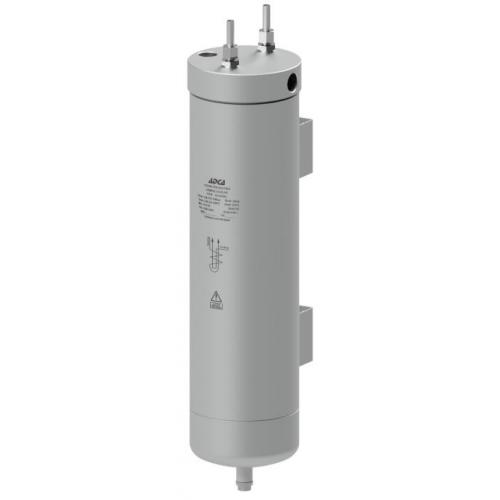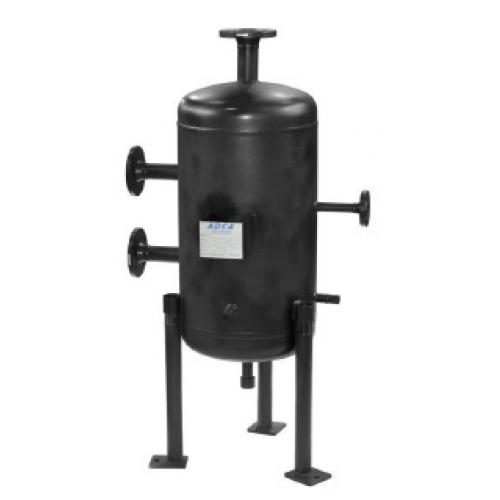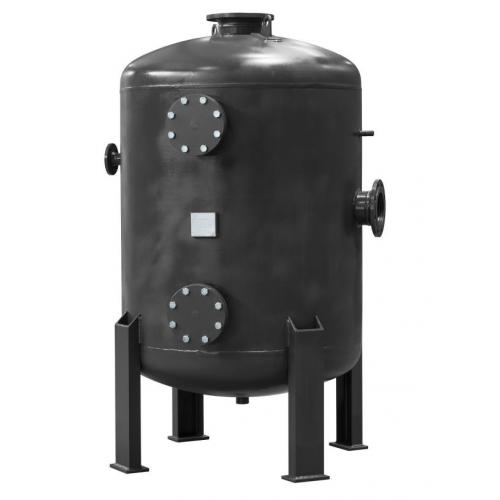- TDS and intermittent blowdown control in one single device.
- Displays conductivity, resistivity, PPM and temperature units.
- Programmable cell constant.
- Versatile IP 66 NEMA 4X (144 x 144 mm) enclosure design.
- Large informative 3,75’’ LCD backlit display.
- Simple intuitive menu structure with soft tactile function buttons.
- Software upgradable via SD card slot – Future proof.
- Volt-free outputs with multiple alarm function options.
- 0(4) to 20 mA analog output for remote monitoring purposes with features including adjustable scaling, selectable on-error states and loop fault detection.
- Digital input suitable for connection to the boiler stand-by/burner contact, to reduce energy waste.

TDS Control System
Blowdown controller BSC220
The ADCATrol BCS220 is a blowdown controller specially designed for use with steam boilers. The device takes care of both TDS and intermittent blowdown controls.
TDS (Total Dissolved Solids) is controlled through measurement of the boiler water electrical conductivity and intermittent control is performed via a blowdown timer.
The device utilizes a clear multifunction LCD to display measured conductivity, temperature, operational alarm status and provide an intuitive user interface. The device is IP 66 rated NEMA 4X and can be panel, surface/wall and pipe mounted.
- Panel mounting kit.
- Pipe mounting kit (50 to 100 mm pipe OD).
- BCS220 – 90 to 265 V AC power supply.
- BCS220-LV – 12 to 30 V DC power supply
Conductivity probe SPS21
The ADCATrol SPS21 conductivity probe is typically used in steam applications to measure the conductivity of superheated boiler water, condensate or feedwater. The probe is used in conjunction with an ADCATrol BCS controller and a VPC series TDS blowdown control valve.
Water contains impurities in the form of dissolved solids and solids in suspension, whose concentration increases during vaporization. Water treatment can reduce impurities to a certain degree, however these are not completely eliminated and, in certain conditions, might even increase. As steam production starts, there is an undesirable increase in boiler water TDS (Total Dissolved Solids) concentration. If not taken care of, the high concentration can lead to problems such as water foaming, reduced boiler performance and wet steam. Contamination of the steam may occur, resulting in system damage further ahead, such as corrosion, scaling, salt incrustations on heat transfer surfaces, among other problems.
Furthermore, the high concentration is harmful and is not acceptable in applications where steam is used for treatment of food, drinks and in sterilization processes.
For these reasons, a certain amount of boiler water must be discharged continuously or periodically to ensure TDS concentration is kept within the recommended parameters.
- Compact stainless steel construction.
- IP 65 protection.
- Wide ambient temperature range up to 100 ºC.
- Sensor chamber for sandwiching between flanges as per EN 1092-1 or ASME B16.5.
- Measure conductivity of superheated boiler water, condensate and feedwater.
- SPS21.
- ½”
- Male threaded ISO 228.
- Installation in pipes via a sensor chamber.
- See IMI – Installation and maintenance instructions.
Conductivity probe SPS33 (Direct boiler mounting)
The ADCATrol SPS33 conductivity probe is typically used in steam applications to measure the conductivity of superheated boiler water, condensate or feedwater. The probe is used in conjunction with an ADCATrol BCS controller and a VPC series TDS blowdown control valve.
Water contains impurities in the form of dissolved solids and solids in suspension, whose concentration increases during vaporization. Water treatment can reduce impurities to a certain degree, however these are not completely eliminated and, in certain conditions, might even increase. As steam production starts, there is an undesirable increase in boiler water TDS (Total Dissolved Solids) concentration. If not taken care of, the high concentration can lead to problems such as water foaming, reduced boiler performance and wet steam. Contamination of the steam may occur, resulting in system damage further ahead, such as corrosion, scaling, salt incrustations on heat transfer surfaces, among other problems.
Furthermore, the high concentration is harmful and is not acceptable in applications where steam is used for treatment of food, drinks and in sterilization processes.
For these reasons, a certain amount of boiler water must be discharged continuously or periodically to ensure TDS concentration is kept within the recommended parameters.
- Available in different lengths.
- IP 65 protection.
- Wide ambient temperature range up to 100 ºC.
- Flanged tee piece type F3220.
- Threaded outer shroud.
- Measure conductivity of superheated boiler water, condensate and feedwater.
- SPS33.
- ½”
- Male threaded ISO 228.
- Horizontal installation. Angled (45º) installation with outer shroud, consult manufacturer.
- See IMI – Installation and maintenance instructions
Conductivity transmitter (TDS) MODEL 350
Conductivity transmitter (TDS) in high pressure and temperature processes.
The Conductivity Transmitter (TDS), Series 350, is specially designed to transmit the conductivity of boiler water and boiler feedwater operating under demanding process conditions of temperature and pressure.
Together with the conductivity probes series 310 and 330 the transmitter series 350 measures and transmits conductivity by generating a 4/20 mA signal through a 2-wire loop in steam boilers and other pressurized equipment with water quality control.
- Power supply: 24V DC +/- 20%.
- Consumption: 1.5 W
- Dimensions: DIN rail - 1 module (120 x 98 x 22.5 mm)
- Output: 4 / 20 mA (galvanic isolation) R Load - 500 Ω
- Temperature compensation: α = 0.0 - 5.0 [%/ºC].
- USB connection port
- Kcell: 0.050 - 4.99 cm-1 (standard)
- USB connection port
- Conductivity range. 0 - 1000 µS/cm std @ 25ºC
- Front indication: Green LED (power supply) - Blue LED (in operation)
Probe for measuring tds (conductivity) MODEL 330 (Pipe mounting)
Conductive probe for conductivity transmission in water supply pipes to boilers.
The conductivity probe, series 330, thanks to its compact design and reduced length is specially designed to transmit the conductivity of the boiler feed water working in demanding process conditions, high temperature and pressure.
Together with the 350 series transmitter it measures and transmits conductivity by generating a 4/20 mA signal through a 2-wire loop in steam boilers and other pressurized equipment with water quality control.
- Operating principle: Conductivity
- Probe body: Stainless steel AISI 303
- Connection: ½" BSP thread
- Electrode insulation: PTFE - PEEK
- Electrical connection: DIN43650-A; Cable gland PG11
- Mechanical protection: IP 65
- Process temperature: 239ºC
- Maximum pressure: 32 bar
- Weight: 300 gr
- Immersion length (thread included): 42 mm
- Kcell: 0.250 cm-1
- Temperature compensation: α = 0.0 - 5.0 [%/ºC].
- Conductivity range. 0 - 1000 µS/cm std @ 25ºC
Probe for measuring tds (conductivity) MODEL 310 (Direct boiler mounting)
Conductive probe for conductivity transmission in high pressure and temperature processes.
The conductivity probe, series 310, is specially designed to transmit the conductivity of boiler water working under demanding process conditions, high temperature and pressure.
Together with the 350 series transmitter it measures and transmits conductivity by generating a 4/20 mA signal through a 2-wire loop in steam boilers and other pressure equipment with water quality control.
- - Operating principle: Conductivity
- - Probe body: Stainless steel AISI 303
- - Connection: Thread ½" - 3/8" BSP
- - Electrode insulation: PTFE - PEEK
- - Electrical connection: DIN43650-A; Cable gland PG11
- - Mechanical protection: IP 65
- - Process temperature: 239ºC
- - Maximum pressure: 32 bar
- - Weight: 500 gr (length 300 mm)
- - Kcell: 0.250 cm-1
- - Temperature compensation: α = 0.0 - 5.0 [%/ºC].
- - USB connection port
- - Conductivity range. 0 - 1000 µS/cm std @ 25ºC
Tds blowdown control valves VPC 26S
When a steam boiler is in operation there is continuous evaporation of boiler water which causes an undesirable increase in TDS (Total Dissolved Solids) concentration. A typical problem that results from this is water foaming, which leads to reduced boiler performance and wet steam. Furthermore, dissolved and suspended solids will carry over into the steam lines, contaminating valves, tubes, heat exchangers and steam traps, leading to corrosion, scaling and erosion. For these reasons, a certain amount of boiler water must be discharged continuously or periodically to ensure TDS concentration is kept within the recommended parameters.
The ADCATrol VPC26 is a control valve specially designed for this purpose and features a multi-stage trim to progressively reduce the energy of the fluid. This makes it ideal for discharge of boiler blowdown at high differential pressures where flashing is a concern.
The valve is suitable for both continuous and on/off TDS control via a PA series reverse action pneumatic actuator or AV series fail-safe spring return actuator.
- Minimized vibrations due to continuous stem guiding.
- Seat and plug sealing surfaces are protected fom erosion at low stroke positions.
- Compact and modular design.
- Multi stage trim for controlled velocity and pressure drop.
- Hardened stainless steel trim with stellite faced plug and seat.
- Tool-free quick exchangeable clamped-in seats, allowing fast and easy inline maintenance procedures.
- Sample valve bottom connection.
- NV400B sample valve.
- Blowdown controllers.
- TDS probes.
- TDS blowdown control in steam boilers and other applications with high pressure drops and low flow rates where cavitation and flashing phenomenon are likely to occur.
- VPC26S – carbon steel.
- VPC26i – stainless steel.
- 1/2" to 11/2"; DN 15 to DN 40.
- Flanged EN 1092-1 PN 40.
- Flanged ASME B16.5 Class 300.
- PA10 linear pneumatic actuator.
- AVF234S linear electric actuator.
Blowdown valves for steam boilers
Intermittent blowdown valves VPA26/2
The VPA26/2 series of blowdown valves were specially designed to remove sludge deposits in steam boilers. These intermittent blowdown valves operate manually or automatically with time control.
This valve is available with a diaphragm actuator and/or manual operating lever.
- High quality hardened seat and plug.
- Manual or automatic intermittent control.
- Lockable in open position if supplied with manual operating lever.
- Convenient foot operated lever.
- Maintenance-free stem sealing.
- Tool-free quick-clamping seats, allowing quick and easy on-site maintenance procedures.
- Air filter regulator.
- Solenoid valve with timer control unit.
- Blowdown controllers.
- Mechanical limit switches.
- Inductive limit switch box.
- Water actuated version.
- Intermittent blowdown of steam boilers.
- VPA26/2S – carbon steel.
- VPA26/2i – stainless steel.
- 3/4" to 2" – DN 20 to DN 50.
- Flanged EN 1092-1 PN 40.
- Flanged ASME B16.5 Class 300.
Heating and Deaeration Boiler Feed water
Atmospheric semi – deaerators ADG
The ADCATherm atmospheric semi-deaerators are designed to heat boiler feed water and to reduce oxygen and carbon dioxide (oxygen values in the feed water of less than 1,6 mg/L can be achieved). Remaining oxygen can be completely removed using oxygen scavenging chemicals.
Basically, the complete system consists of a storage vessel, a deaeration head section and a vent.
- Prevents energy wasting.
- Easy to install.
- Can be installed on new or existing systems.
- Reduces the flow of flash steam from the vessel venting pipe.
- Long life expectancy.
- Complete stainless steel construction.
- Complete system including all the necessary equipments.
- Vent condenser for energy recovery.
- Steam boiler feed water
- ADG – Deaerator head
- Flanged EN 1092-1 or ASME.
- ISO or NPT threaded sockets.
- Different connections on request.
- Carbon steel with internal stainless steel components.
- Deaerator head – vertical installation.
- Storage vessel – cylindrical horizontal design.
- Final dimensions and connections according to the drawing supplied after order confirmation.
Hot return condensate is injected in the bottom of the storage vessel using an adequate sparger pipe and softened make-up water is introduced in the deaerator head to be heated by a contact cascade flash steam heating system (counter-current flow) coming from the vessel. A part of the dissolved gases is liberated from the water at this point, and then to the atmosphere, trough the flash steam vent line.
The semi-deaerated water then falls to the storage vessel below, where a steam injection system will provide an additional deaeration.
The complete unit is supplied, including all the necessary instrumentation for temperature and level control, to be described in our offer, depending on the operation conditions (see Table 1).
Flash condensing heads FCD
The ADCATherm flash condensing heads are designed to promote energy efficiency on new or existing systems.
Mixing the flash steam with the boiler make-up water allows the energy within the flash steam to be fully absorbed into the water and therefore reduces energy waste that normally occurs from the discharge of flash steam through a vent.
The main advantages over some traditional systems are that it is possible to make most of the piping connections in a single and compact mixing unit and a greater heat recovery efficiency can be achieved.
This mixing unit includes the following fluid connections:
- Cold make-up water;
- Condensate return;
- Re-circulating feedwater;
- Vacuum breaker and vent connection;
- Optional connections for flash steam from a TDS (Total Dissolved Solids) heat recovery system.
The mixing unit includes the necessary baffles, spray nozzle, water injector pipe, etc., in order to guarantee the high mixing energy efficiency. The water is finally mixed in the vessel as it passes through an immersion tube, which ensures a quiet operation.
The feedwater is re-circulated using a low power re-circulating pump which will improve thermal efficiency by reducing the temperature stratification.
Additional equipment can be used to improve energy efficiency and accurate control. ADCATrol control valves, steam injectors, exhaust heads and many other items are available from an ADCA supplier.
Since each plant has particular requirements we suggest that a local ADCA distributor is contacted for layout discussion and equipment selection.
- Prevents energy wasting.
- Easy to install.
- Stainless steel construction.
- Reduces the flow of flash steam from the vessel venting pipe.
- Complete system including all the necessary equipment.
- On boiler water feed tanks.
- FCD150, 200, 250, 300 and 400.
- Female threaded ISO 7 Rp or NPT.
- Flanged EN 1092-1 or ASME.
- Different connections on request
- Vertical installation, on the top of the vessel.
- Connections according to the supplied drawing
Adcatherm tray type deaerators TDG
The TDG series tray type thermal deaerators are designed to heat boiler feed water and reduce oxygen and carbon dioxide levels (oxygen levels in the feed water of less than 0,02 mg/l - 0,02 ppm can be achieved). Remaining oxygen can be completely removed using oxygen scavenging chemicals.
Basically, the complete system consists of a storage vessel, a deaeration section and a vent.
- Turndown (max./min. flow) – 100:1.
- Long life expectancy.
- Complete stainless steel construction.
- Complete system including all the necessary equipment.
- Two stage deaerators.
- Vent condenser for energy recover
- Steam boiler feed water.
- TDG – deaerator dome.
- Flanged EN 1092-1 or ASME.
- ISO or NPT threaded sockets.
- Different connections on request.
- Carbon steel with internal stainless steel components.
- Deaerator dome – vertical installation.
- Storage vessel – cylindrical horizontal design.
- Final dimensions and connections according to the drawing supplied after order confirmation.
Returning condensate and softened make-up water are introduced in the deaerator dome to be heated by a contact cascade steam heating system (counter-current flow). Most of the dissolved gases are liberated from the water at this point, and they are released to the atmosphere trough the flash steam vent line.
The deaerated water then falls to the storage vessel below, where a steam blanket ensures that no gases are reabsorbed.
A sparger pipe is installed inside the tank, at the bottom level, providing the necessary heating energy. A second low pressure steam supply may also be necessary.
The complete unit is supplied including all the necessary instrumentation for temperature, pressure and level control, to be described in our offer depending on the operation conditions (see Table 1).
Control and level alarms in boilers
Capacitive level sensor MODEL 451
The capacitive level probe, series 451, is specially designed to transmit liquid level and work in demanding process conditions, high temperature and pressure.
It measures and transmits level by generating a 4/20 mA signal through a 3-wire loop in tanks and boilers.
- Operating principle: Capacitive
- Probe body: Stainless steel AISI 303
- Connection: ½" BSP thread
- Electrical connection: According to DIN 43650-A with cable gland PG11
- Electrode: Coated stainless steel
- Coating: PTFE 12 mm Ø
- Temperature: 220ºC at electrode
- Maximum pressure: 22 bar
- Weight: 1000 gr (length 500 mm)
- Power supply: 24V dc +/- 10%
- Power consumption: 0.9 VA
- Output: 4 - 20 mA (calibrated, with 3" delay) Rmax = 250 Ω
- Accuracy: 0.5 % s.f. Calibration at 25ºC
- End cap: 25 mm length non-sensitive at probe end
- Medium: Water and compatible liquids
- Conductivity: ≥ 5μS/cm
- Available lengths: 500 mm and 1000 mm
Capacitive probe MODEL 452
Capacitive probe for level transmission and control, 3-wire configuration, in high temperature and pressure processes. With pushbutton panel for field calibration.
The capacitive level probe, series 452, is specially designed to transmit liquid level and work in demanding process conditions, high temperature and pressure.
It measures and transmits level by generating a 4/20 mA signal through a 3-wire loop in tanks and boilers.
- Operating principle: Capacitive
- Probe body: Stainless steel AISI 303
- Connection: ½" BSP thread
- Electrical connection: According to DIN 43650-A with cable gland PG11
- Electrode: Coated stainless steel
- Coating: PTFE 12 mm Ø. Compatible with food applications
- Temperature: 220ºC at electrode
- Maximum pressure: 22 bar
- Weight: 1000 gr (length 500 mm)
- Power supply: 24V dc +/- 10%.
- Consumption: 0.9 VA
- Output: 4 - 20 mA (calibrated, with 3" delay) Rmax = 500 Ω
- Accuracy: 0.5 % s.f. Calibration at 25ºC
- End cap: 25 mm length non-sensitive at probe end
- Medium: Water and compatible liquids
- Conductivity: ≥ 5μS/cm
- Available lengths: 500 mm and 1000 mm
High security level prove S800
The 800 series high safety conductive level probe is used in conjunction with the 210 and 211 series level controllers (SIL 2) or with the 220 and 221 series controllers (SIL 3) as a low level or high level alarm mainly in steam boilers or other pressure vessels and equipment with a need for a redundant level alarm system.
- Operating principle: Conductivity
- Probe body: AISI 303 stainless steel.
- Connection: BSP thread.
- Available connection sizes: ½“ and ¾”.
- Electrical connection: According to DIN 43650-A with PG11 cable gland.
- Mechanical protection: IP 65
- Temperature: 220ºC at electrode
- Operating pressure: 32 bar
- Operating temperature: 239ºC
- Electrode: AISI 303
- Electrode lengths available: 500 mm - 1000 mm
- Weight: 400 gr
High safety level controller MODEL 230
Conductivity controller for low level alarm with self-check and latching (SIL-3) 2014/68/EU (PED) - B+D
Electronic controller with self-diagnosis for low level alarm and system blocking according to European directive 2014/68/EU (PED) with B+D (SIL-3) certificate.
To be used together with the 800 series probe for low level alarm in steam boilers or other pressure equipment requiring a redundant level alarm system.
- Safety Integrity Level: SIL 3
- Electronic digital signal processor.
- Dual circuit for conductivity measurement, with compensation electrode.
- 6 different self-diagnostics with 1 minute periodicity.
- Output relays: 2 switched relays 230V - 2.5 A - AC1
- Positive safety burner lockout circuit.
- Numerical display with alarm code
- Minimum water conductivity: 0.5 µS/cm
- Manual test button in standard version
- Power supply: 24V AC/DC - 115 / 230 VAC
- Power consumption: 3 VA
High safety level controller MODEL 230-1
High safety level controller model 230-1
Electronic controller with self-diagnosis for low level alarm and system blocking according to European directive 2014/68/EU (PED) with certificate B+D (SIL-2).
To be used together with the 800 series probe for low level alarm in steam boilers or other pressure equipment requiring a redundant level alarm system.
- Electronic digital signal processor.
- Double circuit for conductivity measurement, with compensation electrode.
- 6 different self-diagnostics with 1 minute periodicity.
- Output relays: 2 switched relays 230V - 2.5 A - AC1.
- Positive safety burner lockout circuit.
- Numerical display with alarm code
- Minimum water conductivity: 0.5 µS/cm
- Manual test button in standard version
- Power supply: 24V AC/DC - 115 / 230 VAC
- Power consumption: 3 VA
High safety level controller MODEL 231
Conductivity controller for high level alarm with self-checking and blocking (SIL-3) 2014/68/EU (PED) - B+D
Electronic controller with self-diagnosis for low level alarm and system blocking according to European directive 2014/68/EU (PED) with B+D (SIL-3) certificate.
To be used together with the 800 series probe for high level alarm in steam boilers or other pressure equipment requiring a redundant level alarm system.
- Safety Integrity Level: SIL 3
- Electronic digital signal processor.
- Double circuit for conductivity measurement with compensation electrode.
- 6 different self-diagnostics with 1 minute periodicity.
- Output relays: 2 switched relays 230V - 2.5 A - AC1
- Positive safety burner lockout circuit.
- Numerical display with alarm code
- Minimum water conductivity: 0.5 µS/cm
- Manual test button in standard version
- Power supply: 24V AC/DC - 115 / 230 VAC
- Power consumption: 3 VA
High safety level controller MODEL 231-1
Conductivity controller for maximum level alarm with self-checking and blocking (SIL-2) 2014/68/EU (PED) - B+D
Electronic controller with self-diagnosis for high level alarm and system blocking according to European directive 2014/68/EU (PED) with certificate B+D (SIL-2).
To be used together with the 800 series probe for high level alarm in steam boilers or other pressure equipment requiring a redundant level alarm system.
- Electronic digital signal processor.
- Double circuit for conductivity measurement, with compensation electrode.
- 6 different self-diagnostics with 1 minute periodicity.
- Output relays: 2 switched relays 230V - 2.5 A - AC1.
- Positive safety burner lockout circuit.
- Numerical display with alarm code
- Minimum water conductivity: 0.5 µS/cm
- Manual test button in standard version
- Power supply: 24V AC/DC - 115 / 230 VAC
- Power consumption: 3 VA
Multi-electrode probe for level control MODEL 710
4-electrode probe for level control in conductive liquids
The compact 4-electrode probe is designed to perform level control in boilers and pressure equipment under demanding temperature and pressure conditions. It is used with the full range of level switches in the 200 range.
- Electrode type: Conductive
- Probe body : stainless steel
- Connection : 1" BSP conical thread
- Electrical connection: DIN 43650A with cable gland Pg9
- Electrode: Stainless steel AISI 303 - ø 5mm L = 94mm
- Coating: PTFE
- Maximum operating temperature: 239°C at the electrodes
- Max. working pressure: 32 bar
- Weight: 750g
Electrode holder for level control by condensing electrodes MODEL 395
Electrode holder for level control by means of for use with 20X series electronic level controllers
For use in all - nothing level control in tanks with fluids compatible with the materials compatible with the materials of manufacture.
- Type of sensor Conductive
- Probe body Stainless steel AISI 303
- Insulation Vitrified ceramic (Al2O3)
- Connection 3/8" GAS
- Stainless steel AISI
- 303 Ø 6MA L=65 mm
- Temperature 250 ºC at electrode
- Maximum pressure 25 bar
- Degree of protection IP40 with cover
- Weight 360 g
Level controller MODEL 203
Level controller for conductive electrodes din rail mounting
Electronic controller series 203 for use with electrode holders and conductive electrodes.
For use in all - nothing level controls in tanks with fluids compatible with the materials of compatible with the materials of manufacture.
- Electrical connection Terminal block
- IP30 protection classification
- Internal components surface mount technology (SMD)
- Front LEDs Green: power supply
- Red: contact status indication
- Sensitivity Standard 10 μS - 10 000 μS on request
- 1 μS - 20 μS / 0.3 μS - 2 Μs
- N.O. contact - 5 A - 230V a.c.
- Power supply 24 or 110 or 230 V a.c.
- Frequency 50 - 60 Hz
- Power consumption 5 VA (ac model)
- Weight 190 g
Controller MODEL 200
Level controller for conductive electrodes
Electronic controller series 200 for use with electrode holders and conductive electrodes.
For use in all - nothing level controls in tanks with fluids compatible with the materials of manufacture.
- Electrical connection: plug-in type; 8-pin decal base.
- Protection rating: IP40
- Internal components: surface mount technology (SMD)
- Front LEDs:
- Green: power supply
- Red: contact status indication
- Sensitivity: standard 10μS - 10.000μS on request 1μS - 20μS / 0.3 μS - 2μS
- Contact: N.O. - 5 A - 230V a.c.
- Power supply: 24 or 110 or 230 V a.c.
- Frequency: 50 - 60 Hz
- Power consumption: 5 VA (ac model)
- Weight: 220 g
- steam boilers
- pumping stations
- thermal power stations
- storage of beverages and food liquids
- water treatment plants
- wells, basins, autoclaves, tanks
- irrigation systems
- bottling and filling machines
- general food plants
- protection against dry running of pumps
Sample Coolers
Sample coolers SC32-SC132
The ADCA sample coolers are specially designed to cool samples of boiler water or steam for analysis.
Sample coolers prevent steam flashing-off from hot pressurised liquid samples, which can be dangerous and may result in an incorrect sample.
This device may be used for boiler water analysis and other sampling or cooling applications compatible with the construction materials.
- Corrosion-resistant body and internals.
- Self draining sample (top inlet, bottom outlet).
- Sample inlet valve.
- Cooling water inlet valve.
- Temperature indicator.
- Bolted cover.
- Different connection sizes and materials on request.
- Double coil high pressure design for larger capacities.
- Steam boilers and hot water systems
- SC32/SS and SC132/SS – stainless steel body and coil
- Cooling water inlet/outlet: 1/2” on body (ISO 7 Rp or NPT).
- Sample tube inlet/outlet: 8 mm O/D.
- Vertical installation. See IMI – Installation and maintenance instructions.
- Cooling water must be at its maximum flow before opening or closing the sample inlet valve, in order to avoid the risk of scalding.
- Sample valve must also be closed before opening the cooling water valve.
- Sample coil should always be completely immersed in water.
- 30 to 60 kg/h of sample liquid at ≈30 ºC with 1 m³/h of inlet cooling water at 15 ºC. For other pressures, temperatures and/or certified values, consult manufacturer
Sample cooler SC32F -SC1232F (with funnel)
ADCA sample coolers SC32F - SC132F are specially designed to cool steam boiler water samples for analysis. These sample coolers prevent the formation of re-evaporation of samples obtained from hot liquids under pressure, which can be dangerous for the integrity of the operator performing the operation and will result in an incorrect water sample. This device can be used for boiler water analysis as well as other types of sampling or cooling applications compatible with the materials of construction.
- Corrosion resistant body and internal parts.
- Self-draining sample (top inlet, bottom outlet).
- Sample inlet valve.
- Cooling water inlet valve.
- Temperature indicator.
- Compression fittings.
- Bolted top plate.
- Different sizes and connection materials on request.
- Steam boilers and hot water systems
- SC32F/SS and SC132F/SS - stainless steel body and coil.
- Cooling water inlet 1/2", outlet 3/4" (ISO 7 Rp or NPT)
- Sampling tube inlet/outlet: 8 mm O/D
- Vertical installation.
- See IMI - Installation and Maintenance Instructions.
- The cooling water must be at maximum flow rate before opening or closing the sample inlet valve to avoid the risk of scalding.
- The sample valve must also be closed before opening the cooling water valve.
- The sampling coil must always be completely submerged in water.
- From 30 to 60 kg/h of sampling liquid at ≈30 ºC with 1 m³/ cooling water inlet at 15 ºC (boilers up to 20 bar - 220 ºC), for other pressures, temperatures and/or certified values, consult the manufacturer.
Sample cooler with screwed cover SC32B-SC132B
ADCA's SC32B - SC132B sample coolers are specially designed to cool steam boiler water samples for analysis.
These sample coolers prevent the formation of re-evaporation of samples obtained from hot liquids under pressure, which can be hazardous to the integrity of the operator performing the operation and will result in an incorrect water sample.
This device can be used for boiler water analysis as well as other types of sampling or cooling applications compatible with different materials of construction.
- Corrosion resistant body and internal parts.
- Self draining of the sample (top inlet, bottom outlet), consult the manufacturer.OPTIONS
- Sample inlet valve.
- Cooling water inlet valve.
- Temperature indicator.
- Compression fittings.
- Different sizes and connection materials on request.
- The cooling water must be at maximum flow rate before opening or closing the sample inlet valve to avoid the risk of scalding.
- The sample valve must also be closed before opening the cooling water valve.
- The sampling coil must always be completely submerged in water.
- Steam boilers and hot water systems
- SC32B/SS and SC132B/SS - stainless steel
Cooling water inlet 1/2", outlet 1/2" (ISO 7 Rp or NPT).
Sampling tube inlet/outlet: 8 mm O/D.
Vertical installation. See IMI - Installation instructions and Installation and maintenance instructions.
Sample sampling chiller SC332-SC432-SC532
ADCA sample coolers SC332-SC432-SC532 are specially designed to cool steam boiler water samples for analysis. These sample coolers prevent the formation of re-evaporation of samples obtained from hot liquids under pressure, which can be hazardous to the integrity of the operator performing the operation and will result in an incorrect water sample. This device can be used for boiler water analysis as well as other types of sampling or cooling applications compatible with the materials of construction.
- Corrosion resistant body and internal parts.
- Auto sample drain (top inlet, bottom outlet).
- Sample inlet valve.
- Cooling water inlet valve.
- Temperature indicator.
- Bolted top plate.
- Different sizes and connection materials on request.
- Steam boilers and hot water systems.
- SSC332/SS, SC432/SS and SC532/SS - stainless steel body and coil.
- All above models are available in high pressure versions e.g. SC332H/SS.
- SC332 and SC332H: Cooling water inlet/outlet: 1/2" (ISO 7 Rp or NPT).
- Sampling tube inlet/outlet: 10 mm O/D. SC432, SC532, SC432H and SC532H: Cooling water inlet/outlet: 3/4" (ISO 7 Rp or NPT).
- Sampling tube inlet/outlet: 10 mm O/D.
- Vertical installation. See IMI - Installation and maintenance instructions.
- The cooling water must be at maximum flow rate before opening or closing the sample inlet valve to avoid the risk of scalding.
- The sample valve must also be closed before opening the cooling water valve.
- The sampling coil must always be completely submerged in water.
- 30 to 60 kg/h of sample liquid at ≈30 ºC with 1 m³/h of cooling water inlet at 15 ºC.
- For other pressures, temperatures and/or certified values, please consult the manufacturer.
Blowdown Expansion Vessel
Blowdown expansion and cooling units BEX
The BEX blowdown expansion and cooling tank is used in modern boiler rooms to cool the blowdowns of steam boilers before they are discharged to the general drainage system.
The boiler blowdowns are discharged into the BEX expansion tank at atmospheric pressure and are cooled by the supply of cold water through a thermostatic control valve which is controlled by a thermostat mounted inside the tank.
If the generated flash steam cannot be recovered or is discharged into the environment, an additional water spray system can be installed inside the BEX tank.
This is mounted on top of the unit and can be controlled directly by another thermostat or by the same control that activates the automatic sludge purge.
- Prevents thermal contamination
- Overflow siphon tube
- Easy to install
- Reduces flash steam flow
- Stainless steel construction.
- Flash steam condensation spray system.
- Complete system including all necessary equipment (shut-off and check valves, exhaust head thermostats, etc.).
- Manifold with several inlets for multiple boiler installations.
- Manhole.
- Equipped with brackets for elevated installation.
- elevated installation.
- Boiler and hot waste water drainage.
- BEX15, 30, 40, 40, 50, 60 and 80 - carbon steel.
- Female thread ISO 7 Rp or NPT.
- Flanged EN 1092-1 PN 16.
- Flanged ASME B16.5 Class 150.
- Vertical installation.
- The inlet of the blowdown tank is always higher than the boiler discharge valves. Therefore, the connecting pipework a low point for draining the boiler.
- See IMI - Installation and maintenance instructions
Blowdown expansion vessels BV
The BV expansion and blowdown cooling tank is used in modern boiler rooms to cool steam boiler blowdowns before they are discharged to the general drainage system. The boiler blowdowns are discharged into the expansion tank BV at atmospheric pressure and are cooled by the supply of cold water through a thermostatic control valve which is controlled by the corresponding thermostat mounted inside the tank. If the flash steam that is generated cannot be recovered or is discharged into the environment, an additional water spray system can be installed inside the BV tank. This is mounted on top of the unit and can be controlled directly by another thermostat or by the same control that activates the automatic sludge purge.
- Avoids thermal contamination
- Stainless steel construction
- Easy to install
- Manhole for manhole.
- Water injection cooling system.
- Stainless steel construction.
- Complete system including all (shut-off and check valves, thermostats, exhaust header, etc.).
- Manifold with several inlets for multiple boiler installations.
- Manhole.
- Boiler blowdown and hot waste water.
- BV3, 4, 5, 6 and 7 - carbon steel.
- Flange EN 1092-1 PN 16.
- Flange ASME B16.5 Class 150.
- Vertical installation.
- The inlet of the blowdown tank is always higher than the boiler blowdown valves. Therefore, the connection pipe is a low point for draining the boiler.
- See IMI - Instructions

